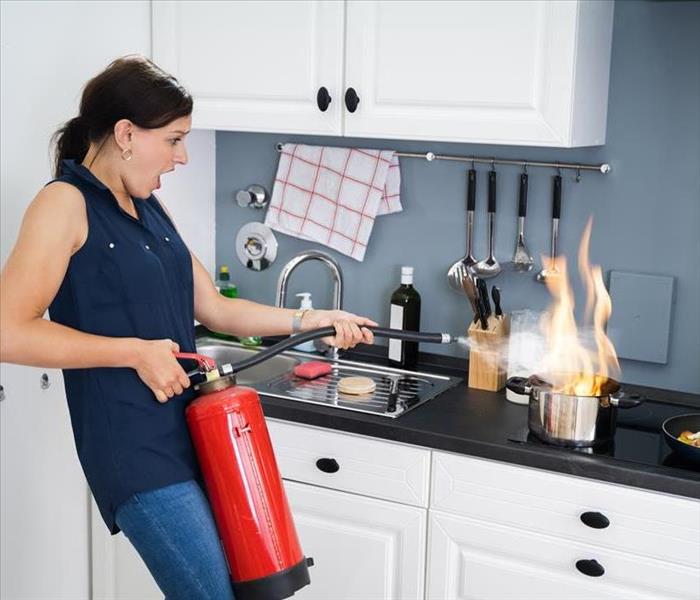The 4 Steps of Operating a Fire Extinguisher
3/16/2022 (Permalink)
A fire in your home in Rocky Mount, NC, can cause immediate panic. You may not know what to do right away. You may have a fire extinguisher in your home, but do you know how to use it? It is a good idea to understand the basics of operating an extinguisher to be prepared in the event of a fire.
The Four Steps of Using a Fire Extinguisher
It is easy to remember the four main steps of operating an extinguisher if you keep the PASS acronym in mind:
- Pull
- Aim
- Squeeze
- Sweep
Pull
The first step is to pull the safety pin from the extinguisher. This action also breaks the tamper seal, the plastic strip wrapped around the safety pin. It ensures the extinguisher is ready to go when you need it.
Aim
When you use the extinguisher, be sure to aim the nozzle at the base of the fire, not at the top. You can help prevent fire damage and put it out more quickly by aiming low. This area is the fire's source. If you are using a CO2 extinguisher, take care not to touch the plastic discharge horn. It gets very cold and can cause skin damage if you contact it.
Squeeze
Once you have aimed the nozzle at the fire's base, squeeze the handle. This step releases the extinguishing agent.
Sweep
Use a side-to-side sweeping motion to discharge the chemicals at the base of the fire. Keep sweeping back and forth until the fire is out.
Watch the area closely, though, and don't assume that the fire is entirely out right away. Flames could start up again. If this happens, repeat the Aim, Squeeze and Sweep steps as needed.
What To Know Before Fighting a Fire
It's essential to know what is burning before you attempt to extinguish a fire. A kitchen fire, for example, may involve grease or cooking oils. An out-of-control campfire in the backyard probably involves wood and paper.
Knowing what materials are burning helps you determine which type of extinguisher you need to use. They come in four different classes:
- Class A extinguishers are rated for wood and paper combustibles.
- Class B extinguishers are designed for flammable liquids such as oil, grease and gasoline.
- Class C extinguishers can put out electrically charged fires.
- Class D extinguishers are made for use on combustible metals.
You can purchase extinguishers designed for multipurpose use, such as an ABC extinguisher. It is a good idea to have multipurpose extinguishers in several places in your home. That way, you are ready for different types of fires.
If you are not sure you can fight the fire, or if it has gotten out of control, evacuate immediately. It is possible to have a professional restoration service come in and repair your home after fire damage. However, your personal safety is the most critical factor.
Knowing how to use a fire extinguisher can save you a lot of time and worry if you ever have a small fire in your Rocky Mount, NC, residence. Keep the PASS acronym in mind to help you remember what to do.




 24/7 Emergency Service
24/7 Emergency Service
